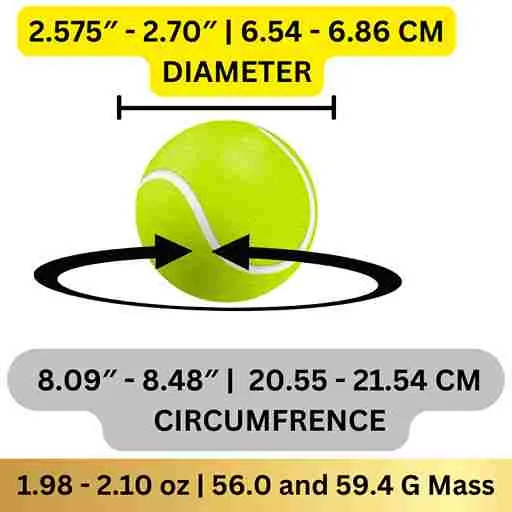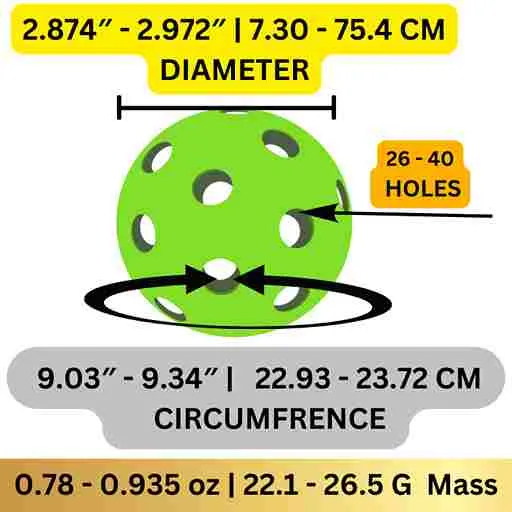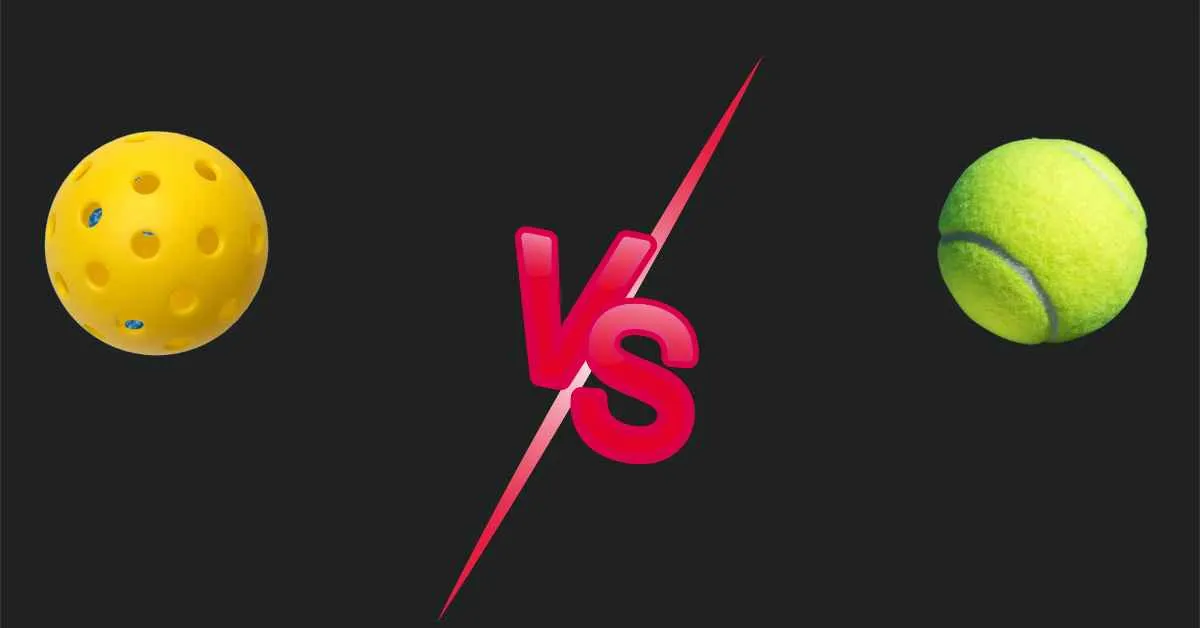Discover the Key Differences Between Pickleball vs Tennis Ball Sizes! Explore the unique characteristics of these sports, essential equipment and make an informed choice. Dive into the world of racket sports today.
When it comes to the world of racket sports, the size of the ball plays a crucial role in determining the dynamics and gameplay of the game. Pickleball and tennis, two popular racket sports, each have unique ball sizes, and understanding the distinctions between them is essential for players and enthusiasts.
In this article, we’ll delve into the intriguing comparison of pickleball vs tennis ball size, shedding light on how these differences influence the games and the equipment used in each sport. Whether you’re a seasoned player or just a curious observer, join us in exploring the nuances that set these sports apart.
Table of Contents
How Pickleball Balls Differ From Tennis Balls
Pickleball and tennis are beloved racquet sports, each with its distinct character and set of equipment. While the differences between the two sports are evident in various aspects, one often overlooked but crucial distinction lies in the size and characteristics of the balls used.
Pickleball Court Size Vs Tennis Court Size You Should Know
Regulations for approved tennis balls
Diameter: The diameter of a typical tennis ball should be between 2.57 inches (6.54 centimeters) and 2.70 inches (6.86 centimeters).
Circumference: The circumference of a standard tennis ball is approximately 8.09 to 8.48 inches (about 20.55 to 21.54 centimeters).
Weight: The ball should weigh between 1.975 ounces (56.0 grams) and 2.095 ounces (59.4 grams).
Bounce: Meeting the standards, a regular tennis ball, when dropped from a height of 100 inches (about 254 centimeters), should demonstrate a rebound bounce height that falls between 53 inches (approximately 134.62 centimeters) and 58 inches (about 147.32 centimeters).
Pressure: A tennis ball’s internal air pressure should be 12.57 psi (pounds per square inch) to 14.21 psi (approximately 0.86 to 0.98 atmospheres). This pressure range is maintained to ensure that the ball retains its bounce characteristics throughout a match.
Felt Cover: The felt covering on a tennis ball should be uniform and free from seams. It should have a consistent nap (the texture of the felt). The color of the felt is traditionally bright yellow or optic yellow, which enhances visibility for players and spectators.
Durability: Tennis balls are required to withstand a certain level of play without losing their bounce or outer felt. The ITF specifies the number of times a ball can be bounced against a hard surface before it is deemed unfit for play.

Color Of A Tennis Ball
The color of a standard tennis ball is instantly identifiable to anyone familiar with the sport. It usually comes in a bright, attention-grabbing greenish-yellow hue, specifically “optic yellow.” However, the journey to this iconic color was complex and involved a bit of the evolution of the tennis ball.
Early Tennis Ball Colors
In the 19th century, The Indian Tennis Association was the first to develop rubber-covered balls containing pressurized air. Tennis balls were primarily black or white. These balls were made from leather and cloth, with their color resulting from the materials used.
The Shift to White
Around the early 20th century, tennis ball manufacturers began producing predominantly white balls. In 1976, recognizing the enhanced visibility of yellow and white on television screens, the International Tennis Federation made a pivotal choice. They decided to permit only these two distinct colors for tennis balls. White balls were an attempt to improve visibility, especially in natural light.
The Optic Yellow Revolution
In the mid-20th century, tennis ball manufacturers introduced the vibrant greenish-yellow, or optic yellow, color. Optic yellow was chosen for its enhanced visibility against the green tennis court background. In the Wimbledon tournament of 1986, a historic change took place. Only yellow tennis balls were permitted, and all white balls were no longer accepted.
Regulation and Standardization
The International Tennis Federation (ITF) regulated and standardized optic yellow tennis balls. These guidelines ensure consistency and fairness in the sport, making optic yellow the official color for professional and competitive tennis balls.
composition of a tennis ball
According to this precise process, two rubber shells are meticulously combined, and then a gas pressurized to 12 pounds per square inch is injected into the completed ball. Tennis balls with a higher air pressure showcase improved bounce and spin characteristics, allowing for faster travel on the court.
A durable nylon or wool felt is tightly bound over the rubber shell. This delays airflow over the ball’s surface and reduces aerodynamic drag, thereby enhancing the ball’s flight characteristics. Tennis balls must bounce between 53 and 58 inches high when dropped from 100 inches onto a concrete floor to meet international standards.
Pickleball Vs Tennis Ball Size
The table below provides a detailed comparison between pickleball and tennis balls, highlighting their size, circumference, bounce, material, weight, primary use in sports, and court size. This side-by-side analysis will help you understand the key differences between these two types of balls commonly used in racquet sports.
| Aspect | Pickleball | Tennis Ball |
|---|---|---|
| Size (Diameter) | Smaller, 2.874 to 2.972 inches | Larger, 2.575 to 2.70 inches |
| Circumference | Approximately 9.00 to 9.25 inches | Approximately 8.09 to 8.48 inches |
| Bounce | Lower bounce compared to tennis | Higher bounce due to felt surface |
| Material | Usually made of plastic or composite | Covered with felt and rubber core |
| Weight | Lightweight, typically 0.78 to 0.935 oz | Heavier, typically 1.975 to 2.095 oz |
| Use in Sport | Mainly used in pickleball, a racquet sport | Primarily used in tennis, a racquet sport |
| Court Size | Smaller court for pickleball, 20 feet wide and 44 feet long | Larger court for tennis, 27 feet wide and 78 feet long |
Standards for authorized pickleballs
Specifications for permitted pickleball equipment and court dimensions are typically defined by the official rules and guidelines set forth by governing organizations such as the International Federation of Pickleball (IFP) and the USA Pickleball Association (USAPA).
Color Of A Pickleball
The USAPA regulators have taken a practical approach to defining the acceptable colors for Pickleballs. No strict official mandates allow players to make their color choices. Typically, the color selection depends on the court’s environment to ensure the best possible contrast with the surroundings. This ensures that the ball is easily visible to players during the game.
Construction Of A Pickleball
- Core: The core is made of solid plastic, crucial in determining the ball’s weight and bounce.
- Perforations: The core has small holes or perforations, allowing air to flow through the ball. This design feature helps regulate the ball’s speed and bounce during play.
- Shell: The outer layer of the pickleball consists of a thin plastic shell. This shell protects the core and gives the ball its characteristic shape.
The construction process for a pickleball follows a systematic procedure.
- First, a solid plastic core is molded to create the ball’s foundation.
- Next, this core is carefully punctured with perforations to facilitate airflow.
- Subsequently, a thin plastic shell is molded around the core, encapsulating the entire structure.
- Finally, the finished ball undergoes trimming and polishing to meet quality standards.
It’s important to note that this construction process is typically automated and performed by machines to ensure consistency and precision in the final product.

Dimensions Of A Pickleball
Circumference: The circumference of a standard pickleball is approximately 9.03 and 9.34 inches inches (around 22.93 to 23.72 centimeters).
Diameter: A pickleball’s standard Diameter ranges from 2.874 to 2.972 inches, approximately 73.0 to 75.4 millimeters.
Weight: The weight of a standard pickleball ranges from 0.78 to 0.935 ounces, which is about 22 to 26.5 grams.
Bounce: A pickleball is designed to have a consistent bounce. When dropped from a height of 78 inches (approximately 2 meters) above the playing surface, it should rebound to 33 to 34 inches (about 83.8 to 86.4 centimeters).
Exploring Specialty Ball Variants in Pickleball and Tennis:
Pickleball and tennis provide interesting specialty ball types within standard ball sizes worth exploring.
Pickleballs for Specific Play Styles:
- Indoor balls: Designed for rugged, smooth courts, offering improved control and shot precision.
- Outdoor balls: Crafted from more durable plastic materials to withstand outdoor play in the wind and on rough surfaces.
- Low compression balls: Ideal for beginners learning proper technique, slowing down the game for skill development.
Tennis Balls for Different Situations:
- Pressure less balls: Maintain bounce consistency even as they age, extending playing time.
- Extra duty felt: Boasting higher denier strength felt material, these balls last significantly longer.
- High visibility balls: Featuring fluorescent colors like orange for enhanced visibility on dark courts.
Trying out these diverse ball variants introduces subtle gameplay changes while staying within the expected size ranges. Don’t hesitate to explore and experiment.
The Influence of Pickleball Size on Gameplay
The smaller size of the pickleball has several distinct effects on gameplay compared to tennis:
More Volleying Opportunities: The slower ball speed in pickleball allows players to engage more frequently at the net than at the baseline. Mid-court volleys have become a familiar and integral part of the game.
Slower Reaction Time Needed: The pickleball’s gently arcing trajectory of the paddle gives players more time to react to shots. This slower pace makes it easier for players to track the ball’s movement visually.
Lower Spin Impact: In pickleball, the impact of topspin or backspin on the ball is less dramatic than in tennis. The pickleball’s plastic surface does not grip the paddle face as much, reducing the influence of spin on ball movement.
More accessible for Beginners: The smaller pickleball’s slower pace, reduced spin factors, and gentler game dynamics make it more accessible to beginners. New players can grasp the basics of pickleball more quickly, leading to a faster learning curve and an enjoyable experience.
In essence, the smaller size of the pickleball promotes a more accessible and enjoyable game, suitable for players of all ages and skill levels. It is light enough for kids to play quickly, while the smaller court dimensions make it manageable for seniors to cover.
The Impact of Tennis Ball Size on the Game
In contrast to pickleball, the larger, fuzzier tennis ball contributes to a faster and more intense game of tennis, with the following effects:
More Baseline Tactics: Tennis players tend to stay back near the baseline to control the speed of groundstrokes. Volleying is riskier in tennis due to the higher ball speed, which results in more extended rallies from the backcourt.
More complicated to Volley: A tennis ball’s speed, bounce, and spin characteristics make volleying more challenging. Players need quick reflexes and precise timing to block and return fast volleys near the net.
Quicker Reaction Time: Tennis players must react quickly and anticipate the ball’s trajectory due to the higher velocity of the ball coming off the racquet. Anticipation skills play a vital role in tennis.
Advanced Challenge: Tennis offers a steeper learning curve as players must master various skills, including spin control, pace variation, and footwork. The giant balls in tennis make it more difficult to achieve mastery, particularly for beginners.
The giant, fuzzier tennis ball in tennis emphasizes speed, power, and athleticism. While it can be highly satisfying for athletes, it makes tennis a more challenging and demanding sport to pick up casually, especially for beginners.
Custom Ball Sizes – Taking Sports to the Next Level
For those seeking extra variety, custom ball sizes provide an opportunity to spice up your game beyond the usual pickleballs and tennis balls. Here are some imaginative options to add excitement to your next match:
Oversized and Mini Pickleballs:
- Jumbo pickleballs: These, being nearly the size of a tennis ball, increase speed and power.
- Wiffle-style pickleballs: Tiny perforated plastic balls bounce wildly and are more challenging to control.
Alternative Tennis Balls:
- Foam balls: Large, soft foam balls are a secure choice for indoor play.
- Low compression balls: Specialty oversized balls bounce lower and are beginner-friendly.
- Beach tennis balls: Lighter and a bit smaller, making them ideal for playing in sand and windy conditions
Exploring custom ball sizes is a fantastic way to test your skills in exciting new ways. Remember to ensure that your nets, paddles, and court sizes align with your chosen ball type for the best gaming experience.
CONCLUSION
In the world of racquet sports, the size of the ball plays a pivotal role in shaping the overall experience. Pickleball’s smaller and lighter ball offers a more relaxed and inclusive gaming environment, while tennis’s larger and faster ball size intensifies the competition. Ultimately, the choice between pickleball and tennis comes down to personal preferences and the desired level of challenge. Both sports provide unique and enjoyable experiences for enthusiasts of all ages and skill levels.

